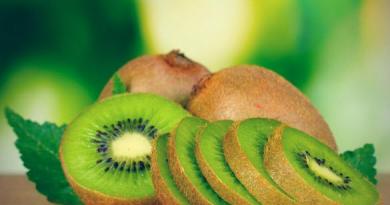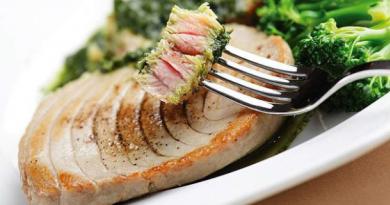Why does this "cunning" mushroom have a fruity smell? Where do chanterelles grow and how to cook them properly? Composition, calorie content, useful properties and contraindications for use.
The content of the article:
Chanterelle (Cantharellus) is a fungus of the Chanterelle family, which grows in coniferous and mixed forests, enters into symbiosis with trees, forming large "families". It owes its name to the characteristic light color: from yellow to orange. Outwardly, the mushroom cap resembles a saucer (from two to twelve centimeters in diameter) with wavy and uneven edges and a recess inside, and the stem is smoothly connected to the cap and tapers slightly towards the ground. Chanterelles grow in Europe, Asia, North America, Africa, the Himalayas and Malaysia, choosing shady places with wet moss. This mushroom is present in many classic recipes of Russian cuisine, as well as European. Chanterelle can be fried, stewed, boiled, baked in the oven and even added to vegetable stew.
The composition and calorie content of fresh chanterelles
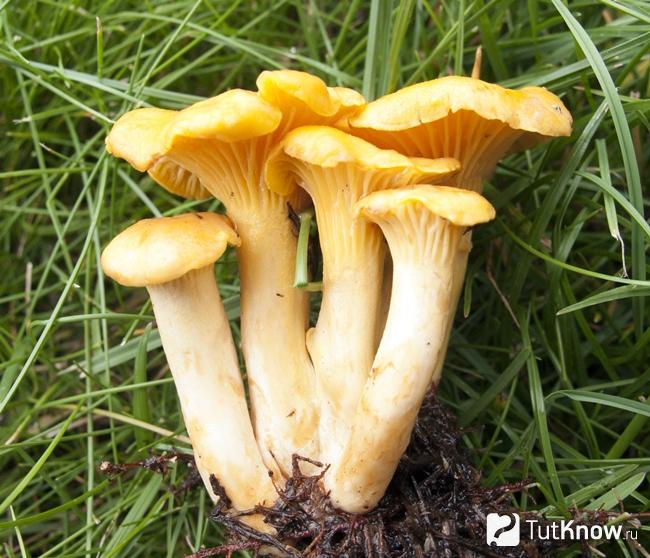
The composition of chanterelle mushrooms includes 8 different vitamins, among which there is beta-carotene, as well as more than 20 different substances and elements.
Calorie content of chanterelles - 19 kcal per 100 g of product, of which:
- Proteins - 1.5 g;
- Fats - 1.1 g;
- Carbohydrates - 1 g;
- Dietary fiber - 7 g;
- Water - 88.5 g;
- Ash - 1;
- Organic acids - 1.5 g.
- Potassium - 450 mg;
- Calcium - 4 mg;
- Magnesium - 7 mg;
- Sodium - 3 mg;
- Phosphorus - 44 mg;
- Sulfur - 40 mg;
- Chlorine - 24 mg.
- Iron - 0.7 mg;
- Cobalt - 4 mcg;
- Manganese - 0.41 mg;
- Copper - 290 mcg;
- Fluorine - 55 mcg;
- Zinc - 0.26 mg.
Vitamins per 100 g:
- Vitamin A, RE - 142 mcg;
- Vitamin B1 - 0.01 mg;
- Vitamin B2 - 0.35 mg;
- Vitamin C - 34 mg;
- Vitamin E - 0.5 mg;
- Niacin - 4.9 mg;
- Vitamins PP, NE - 5 mg.
- Terpenoids dihydroactinidiolide - present in woodruff grass and creates a "sweet" smell.
- Limonene - found in the peel of citrus fruits (orange, lemon, etc.).
- Benzaldehyde - the most famous source of this element, and therefore the smell, is bitter almonds.
- Phenylacetaldehyde - found in the composition of many flowers, for example, hyacinth.
Useful properties of chanterelle mushrooms

200 grams of chanterelles completely fill the daily need for iron (for women), vitamin C, magnesium, sodium, chlorine and sulfur.
The benefits of fresh chanterelles and dishes containing them:
- They improve the vascular system, which helps with headaches, drops in blood pressure, numbness of the arms or legs, as well as pain in the neck and back.
- They help with low acidity of the stomach, acid disorders, level the acid-base balance.
- Improve the appearance of the skin and prevent hair loss thanks to sulfur and niacin.
- Thanks to vitamin C, they strengthen the immune system and help fight colds.
- The iron in chanterelles increases hemoglobin, helping to fight anemia (anemia).
- Microelements contained in chanterelles improve all mucous membranes. So, they have an effect on the mucous membrane of the eye, which increases resistance to various infections.
- Various liver diseases are treated with special extracts from fresh chanterelles in European countries.
Harm of chanterelles and contraindications for use

Chanterelles, like many other mushrooms, have a rich composition, which leads to some contraindications for use. They should be used with caution in the following situations:- gallbladder problems. In this case, be careful, you can eat mushrooms with the permission of your doctor.
- Indigestion. Like all mushrooms, chanterelles are a heavy food that should be eaten in limited quantities.
- Diarrhea. If improperly prepared, they can cause persistent indigestion, requiring medical intervention.
- Diseases of the gastrointestinal tract. Pickled chanterelles should be used with caution, because. mushrooms require a fairly large amount of vinegar for pickling.
- Poisoning. If the time of the necessary heat treatment of chanterelles is violated, this can lead to poisoning.
- Botulism. Incorrect preservation of meat or mushrooms, which leads to the formation of the bacillus Clostridium botulinum, which causes a rather rare but serious disease.
- . In no case should you buy chanterelles from your hands, which only partially fit the description of edible ones, and also collect them yourself with care - “false” chanterelles are extremely poisonous.
Contraindications to chanterelles (in which cases you can not use it at all):
- Liver diseases - mushrooms can provoke an exacerbation of the disease. When exacerbated, they cause indigestion.
- Kidney disease - chanterelles contain some essential oils, which is an irritant to kidney tissue.
- Diseases of the gastrointestinal tract - mushrooms can not be eaten at all: they can worsen the condition, and with prolonged remission - renew the disease.
- Cholelithiasis - mushrooms, due to their composition, load the gallbladder too much, which can lead to the need for surgical intervention.
Symptoms of mushroom poisoning come on very quickly. In case of poisoning with “false” or improperly prepared chanterelles, it is necessary to call an ambulance and immediately rinse the stomach several times.
In general, it is very easy to avoid the harm of chanterelles, just follow some recommendations for use and cooking technology.
Chanterelle Mushroom Recipes
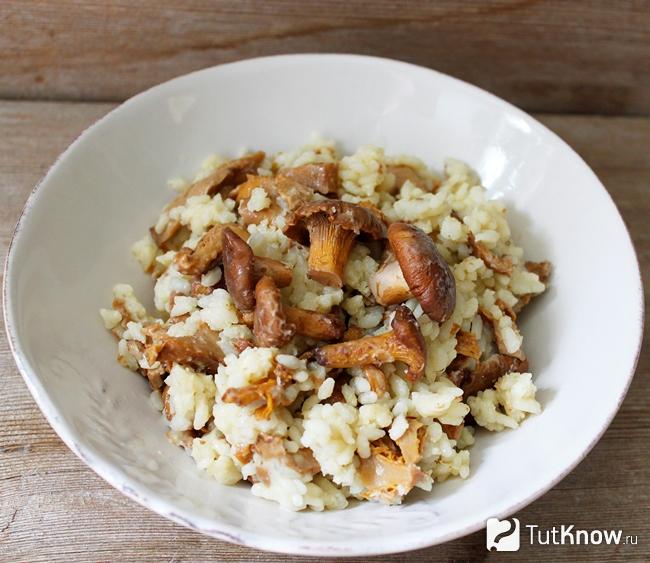
This mushroom has one distinctive feature: chanterelles are eaten both raw and after heat treatment. However, raw chanterelles are used only as a medicine for fungotherapy, so we have selected for you several recipes from chanterelles after heat treatment:- Pie with chanterelles and chicken liver. Peel 400 grams of the liver, “grab” with a light crust with a short roast. Rinse 400 grams of chanterelles, cut into medium slices, add salt, simmer in a pan until the liquid is reduced by half. Beat sour cream (250 ml) and 1 egg, add salt and herbs to taste, mix with mushrooms and liver. Roll out any favorite dough for unleavened pies, spread the mold evenly, forming sides. Lay out, avoiding bumps, the resulting mixture on the dough. Bake in the oven at 200 degrees for 10-15 minutes, without covering with anything.
- . Rinse and dry 600 grams of fresh chanterelles, cut large ones into several pieces. Fry the chanterelles with a pre-passivated half of the onion in small cubes. Fry until light golden brown. Add some garlic, ground black pepper and salt to taste. Transfer the mixture to the oven and bake for 10-15 minutes at a temperature of 200 degrees. Cut the second half of the onion into small cubes, fry in butter. Then you can add some olive oil. Pour 200 grams of washed rice into the pan, fry until the rice becomes transparent. In the next step, you can add a little red wine for sourness. Gradually add water (salted) or broth to the rice as it boils until the rice becomes soft. Put the finished chanterelles in rice, mix. Sprinkle with grated soft cheese before serving.
- Vegetable stew with chanterelles. Fry onions (200 grams) in a cauldron, add 1 kg of peeled and chopped chanterelles to it, add salt to taste, simmer until almost ready, let cool in a separate bowl. Salt sweet peppers (300 grams) and eggplants (300 grams), fry in a cauldron until soft with garlic and herbs. Grind tomato pulp without skin (1.7-2 kg) in a blender or meat grinder, pour into a cauldron, add chanterelles with onions and simmer over low heat for 30 minutes after boiling. Serve with rice or boiled potatoes.
- Cream sauce with chanterelles. Rinse 400 grams of chanterelles, cut into small cubes, cook for 20-30 minutes after boiling. Drain into a colander, let cool. Onion (200 grams) cut into small cubes, fry until almost ready. Add chanterelles to it, salt to taste, simmer for 5-10 minutes. Pour in the cream (250 ml), add allspice ground pepper to taste, simmer until the sauce becomes thick. Sprinkle with fresh chopped herbs before serving.
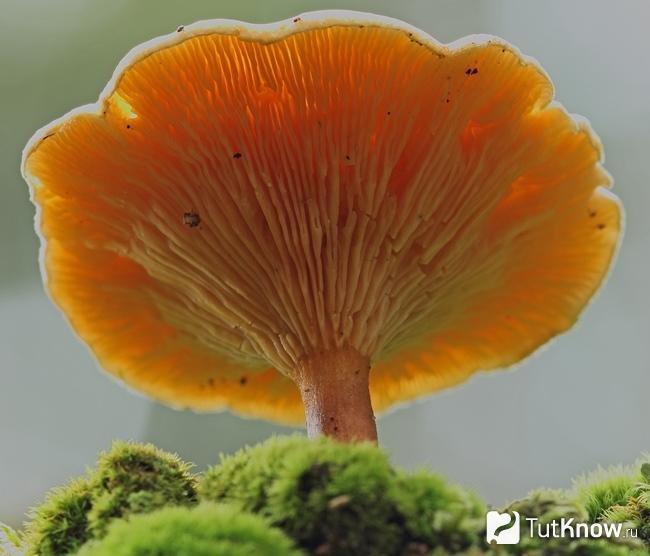
There is a common misconception about the origin of the name "chanterelles": many people think and even write that the root of the word "fox" and the origin of the appearance (wavy and fluffy). However, this is not entirely true, although there is something in common between foxes and chanterelles. Chanterelle mushrooms are not named after fluffy animals that have been so popular lately, but from the word “fox”, which in translation from Old Russian sounds like “yellow”, which gave its name to one chanterelle and another."False" chanterelles (Hygrophoropsis aurantiaca) are considered conditionally edible in many European countries, as well as in Russia and England, due to an unpleasant smell, loose texture and isolated cases of poisoning.
It is very simple to distinguish them from officially edible mushrooms:
- The “false” chanterelles have an almost perfectly even round hat and a hollow, even leg, while the real ones have uneven geometry, wavy and fluffy edges, a fleshy leg, tapering to the bottom.
- "False" chanterelles are usually much smaller in size.
- The plates under the hat of these mushrooms break off in one line, and do not smoothly descend, unlike edible chanterelles.
- When pressed on the flesh of a fresh chanterelle, a pinkish trace remains.
- And finally, real chanterelles are very rarely wormy.
We talked about the substances that characterize the “apricot” smell of chanterelles above, but there is an interesting fact on this topic: chanterelles and apricots have only two common aromatic compounds (1-octen-3-ol and hexanal), but none of them it smells like fruit!
In Jewish culture, due to the fact that there are almost no worms in these mushrooms, chanterelles are kosher.
In fungotherapy, chanterelles are used to cure various liver diseases, restore vision and treat night blindness, treat diseases of the upper respiratory tract, pancreas, and also as a weight loss agent and antioxidant. In China and Japan, dietary supplements are produced based on chanterelle extracts.
How to cook chanterelles - look at the video:
The popularity of chanterelles can be explained by the fact that they have a pronounced smell, they do not need to be subjected to long heat treatment, they are considered one of the best mushrooms in terms of taste, they are easy to find in the forest, and on our shelves you can always find a “fresh basket” with these amazing mushrooms.


